Hiroshi Miyamura and his hometown had a lot in common. They believed in America.
Two American soldiers trudged across the war-torn Korean peninsula as winter bore down.
To keep their minds off the cold and hunger, Hiroshi “Hershey” Miyamura told his new friend, an Italian kid from Boston, about his hometown of Gallup, N.M.
Joe Annello pictured the kind of strange buttes and red-rock desert he had seen in John Wayne movies. But Miyamura told him a different story, about how Gallup had risen to defend the American ideal when so many others stood by.
Sixty-seven years later, their enduring friendship is a testament to how a small town grappled with issues the nation is again debating today — where people of certain ethnic or religious backgrounds fit into its changing identity. It is the story of how a small act of courage helped turn an "enemy alien" into an American hero.
A town of cowboys, Indians and immigrants
When Miyamura was a boy, he told Annello, Gallup was a rough-cut lot of newcomers and Native Americans, a railroad stop on the windswept Colorado Plateau known for its rowdy bars, cathouses and knuckle-breaking prizefights.
They worked as coal miners, train mechanics, barkeeps, cowpunchers, lumberjacks, shepherds and Indian traders — Slavs, Italians, Finns, Russians, Irish, Greeks, Mexicans, Navajos and Zunis.
Hiroshi’s parents came to Gallup in 1923 and opened a lunch stand. His father, Yaichi, had traveled the American West years before, visiting
Within a year, the couple bought a popular 24-hour-diner called the OK Cafe in the main shopping district on Coal Street, just a block off Route 66. Their growing family lived in the basement -- Hiroshi, the fourth of seven children, was born in 1925.
Hiroshi knew little about Japan. His mother died when he was 11, and his father never talked about his native land. The family spoke English at home and never saw themselves as anything but American.
Hiroshi joined the Boy Scouts and delivered newspapers on his bike. After school, he ran wild with his friends, shooting his BB gun in the rabbit brush, playing “Hopalong Cassidy” and “Flash Gordon,” digging caves in the banks of the dusty Puerco River.
They staged boxing matches in the alley behind the restaurant and goaded each other with the ethnic slurs of the time.
Miyamura took the nickname “Hershey” when his teacher couldn’t pronounce Hiroshi.
The only time he spent with the other 25 Japanese families in Gallup was on Sunday, when they gathered in an old dining car they had turned into a Japanese Free Methodist Church.
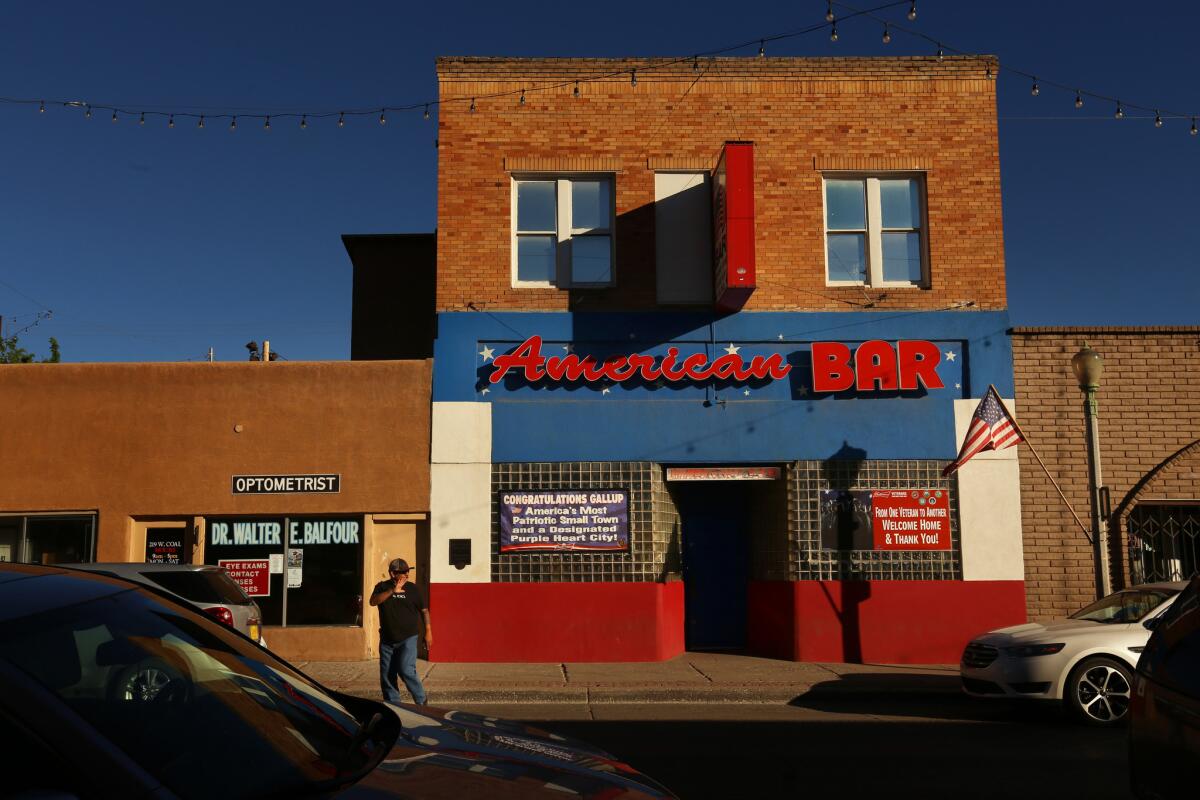
One winter Sunday an Irish friend took him bird hunting. When they returned to town that evening, they heard on the radio that Japan had bombed Hawaii.
The principal called an assembly the next day. He told the students not to blame their Japanese classmates.
In a city of just 7,000, the Japanese American families were firmly stitched into the community. Some owned diners. Others repaired cars. Several of the boys were star basketball and football players.
The town’s new sheriff, Dominic “Mickey” Mollica, told the Japanese families that they would be treated like his own Italian family would be.
At first, the nation largely took the same stance. Federal officials had been investigating the Japanese Americans for years and found no sign they would support Imperial Japan in a war. Intercepted cables showed that Tokyo saw the emigrants in America, the Nikkei, as traitors to their ancestral land.
But the government’s hands-off policy for Japanese Americans eroded quickly, as day after day headlines announced Japan’s assaults on Hong Kong, Malaya, the Dutch East Indies and the Philippines.
In February 1942, President Franklin D. Roosevelt signed Executive Order 9066, the first of the orders that would ultimately incarcerate 120,000 West Coast Japanese, more than 60% of them citizens of the United States.
Months later, Miyamura stared at the Japanese faces in the windows of trains going east, thousands of them, heading to two internment camps in Arkansas.
Because Gallup sat outside the vulnerable coastal “military zone,” the federal government did not mandate that the Japanese leave their homes. But small towns such as Clovis, N.M., and Winslow, Ariz., took it upon themselves to remove their Nikkei residents. In some towns outside the military zone, Japanese workers were fired, evicted, assaulted and spat at, and schools told them to keep their children at home.

‘We are not going to round them up’
Mollica, a 34-year-old former federal marshal, set the tone in Gallup, backed by his friend Guido Zecca, the commander of the Veterans of Foreign Wars post. According to Zecca’s son’s fading recollections of the time, when talk arose over the Japanese, Mollica told their dad: “They are citizens here, and we are not going to round them up.”
Zecca, who had been appointed the leader of local civil defense after Pearl Harbor, agreed.
Nikkei men kept their jobs at the rail yards, and families still gathered on Sundays at the train church. Students at Gallup High School elected Japanese boys as class presidents three times during the war.
But even Gallup saw sporadic incidents of bigotry.
One young man was fired from his job at the grocery store because a customer didn’t want a “Jap” handling her food. Hiroshi’s sisters said cowboys who drove in from the outlying town of Ramah would yell insults at them, telling them to go home.
Hiroshi had never thought he was anything other than American. Now he knew that other people saw him differently.
Like many a 16-year-old boy, especially a shy, slightly built one, he was trying to prove he was a man.
His added burden was proving he was an American.
He started entering prizefights and joined the ROTC his senior year. After graduation he was sent to train with the Army’s highly decorated 442nd Regimental Combat Team — though by the time he reached Europe, the war against Italy and Germany was over.
Back in Gallup, he met a young woman from Winslow, Terry Tsuchimori, whose family had spent much of the war at the internment camp in Poston, Ariz. She had an easy warmth and self-deprecating humor that slowly drew him out. They married in June 1948.
Two years later, Miyamura was redeployed to the American-occupied island of Kyushu, where his father had grown up. He was training to lead a heavy weapons platoon of the 7th Infantry Regiment, 3rd Army Division, in America’s “police action” against North Korea.
Although many fellow U.S. soldiers still resented Japanese Americans, he became friends with another squad leader. Joe Annello came from the west end of Boston and counted Italian, Polish, Jewish, Irish, Russian and Portuguese boys as his friends, speaking bits of their languages. But he had never seen a Japanese man.
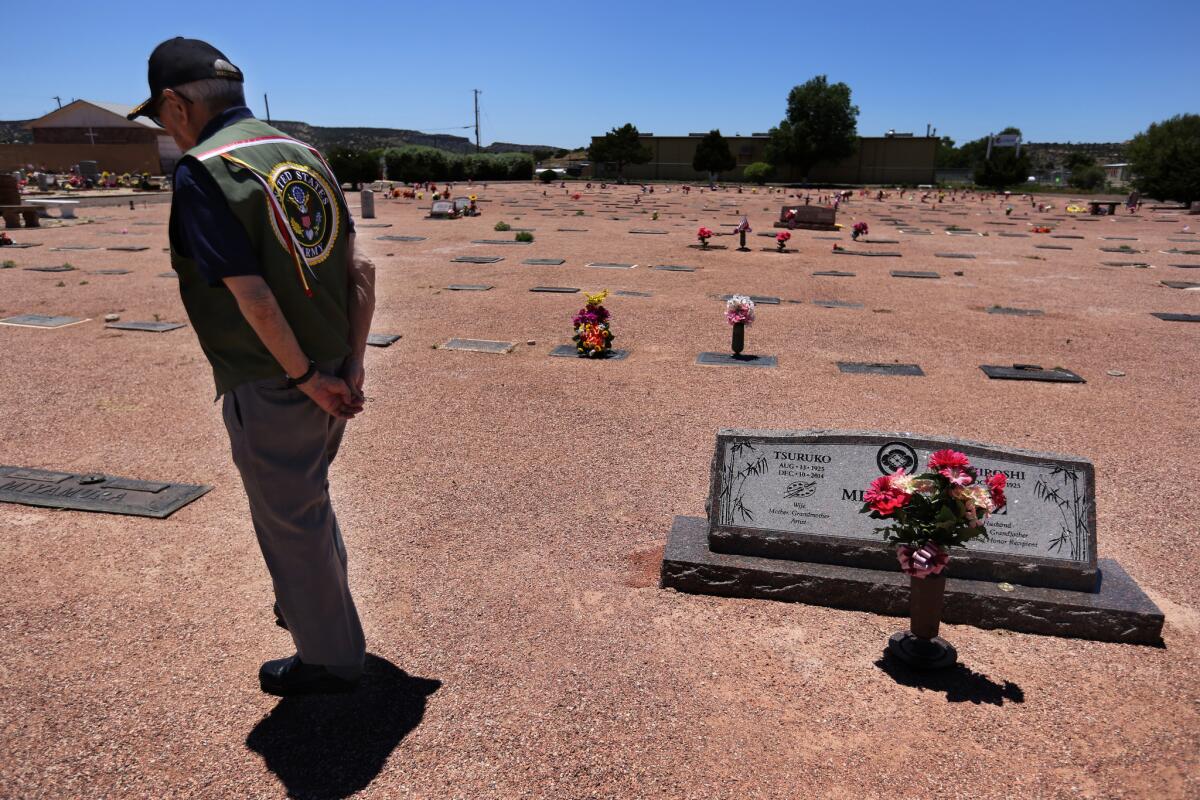
‘Wake up, everybody!’
They hit the beaches of North Korea in November 1950 and marched into the barren mountains just before the war turned into an icy hell that forced the Americans to retreat. The experience sealed their friendship.
By spring, their squads were back in the belly of the Korean peninsula, engaged in fierce firefights with the Chinese.
On April 24, they dug in on a hill just north of the “Kansas Line” that separated the Chinese from the U.N. forces near the 38th parallel.
The hillside was a waste of scorched trenches and craters, littered with spirals of razor wire.
That night, Miyamura couldn’t see or hear anything in the valley below.
Clouds blocked the moon and stars.
“Wake everybody up,” he whispered.
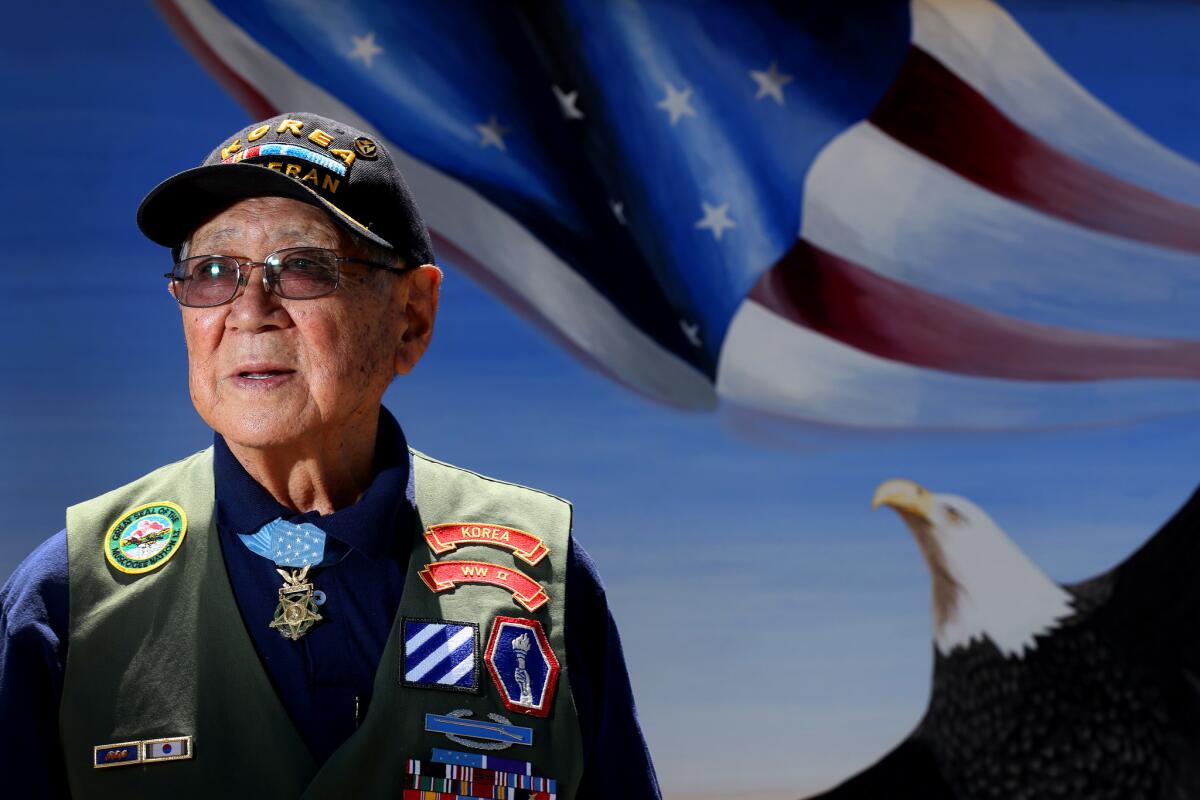
In the valley, a trip flare had ignited. In its light, the men glimpsed masses of silhouettes creeping up the hill.
They hit Annello’s squad immediately, and Miyamura’s a minute later. The American machine gunners mowed them down. Green and red tracer rounds lit up the night.
The Chinese fighters continued to run straight to their deaths, so many of them that Miyamura feared they might run out of ammo. The ground around the guns glittered with brass shell casings, and the smell of blood ran rank.
After two hours of withering fire, Miyamura’s squad was down to 200 machine gun rounds. He ordered his men to fix the bayonets on their M1 rifles.
The enemy closed in just yards away. Miyamura leaped up from his trench and unloaded eight shots into them, then lunged with the bayonet, lancing whoever he could with his boxer’s speed.
Before long, he realized their position was futile. He needed to save his squad.
“You guys get out of here!” he yelled, firing to cover their withdrawal. When the gun jammed, he kept the Chinese back with another clip in his rifle, then grenades, before jumping into the trenches to get back to the safety of the American line.
Rounding a bend, he surprised a Chinese soldier. He skewered him with his bayonet and shot him simultaneously, but the man managed to lob his own grenade. Shrapnel seared into Miyamura’s leg.
Still, he kept moving up the trench, ripping through razor wire until he collapsed from blood loss and exhaustion.
When he regained consciousness, he was a prisoner.
‘You got to keep going’
Annello, too, had been captured. A grenade had taken a divot of flesh near his spine, and he could barely walk.
The prisoners started a forced march north. Miyamura carried most of Annello’s weight.
The Chinese guards kept prodding them with their rifle butts, and after 10 miles, they ordered Miyamura to put his friend down.
He winced and ignored them. They threatened to shoot him.
“Put me down, Hersh,” Annello said. “I can’t go on.”
The guards motioned that they were about to shoot.
“You got to keep going,” Annello said.
“I’m sorry, Joe,” said Miyamura.
The prisoners of war marched 300 miles over five weeks. Stragglers were shot or bayoneted. The Chinese gave the survivors tiny sacks of millet and barley, ground to dust and crawling with weevils. They grew emaciated and ate dandelions and grass to fill their stomachs. Miyamura hallucinated that he was sitting at his dad’s restaurant counter, eating pancakes.
He spent the next two years at Camp 1 in Changson, near the Chinese border, fighting starvation as fellow POWs died of dysentery and infections.
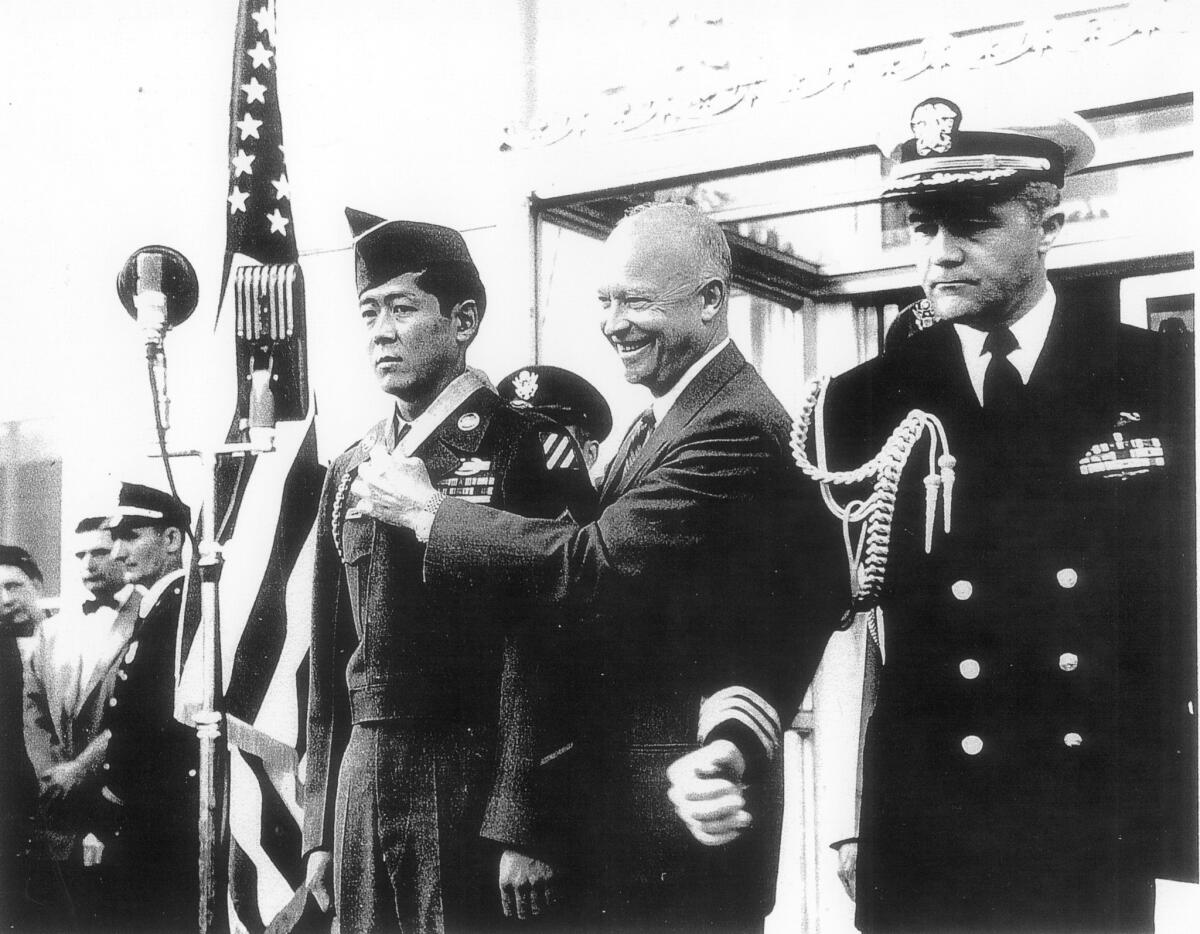
‘Are you Cpl. Hiroshi Miyamura?’
On July 15, 1953, the Americans and North Koreans signed an armistice.
On Aug. 20, Miyamura boarded a Soviet truck for the American base at Freedom Village in the Demilitarized Zone. At 5 feet 10, he weighed less than 100 pounds.
Tears streamed down his face when he saw the American flag.
“Are you Cpl. Hiroshi Miyamura?” an Army captain asked.
They walked to a Quonset hut where a brigadier general stood behind a desk and greeted him as a sergeant, indicating he’d been promoted.
“Sgt. Miyamura, you have been awarded the Congressional Medal of Honor.”
The media asked him how it felt to win the military’s highest honor. He just wanted to go home.
On Sept. 8, he stood at the rail of the U.S. naval ship Marine Adder as it cruised under the Golden Gate Bridge.
A bustling crowd waited on the docks in San Francisco. The generals asked Miyamura to walk down the gangplank first, with officers on the dock saluting him. Asked to speak, he tried to keep his voice from shaking.
“I’m happy to be back,” he said. “This is the most wonderful country in the world.”
When he got back to Gallup, the city schools were let out and businesses closed in his honor. Some 5,000 people greeted him as he got off the train — a celebration organized by Mickey Mollica, now mayor, and his friend Guido Zecca, a state senator.
Mollica declared it “Hiroshi Miyamura Day.”
At the White House to receive his medal, Miyamura trembled so much that President Eisenhower promised he wouldn’t bite him. His dad shook Ike’s hand — the proudest moment in his life, he would say.
Upon his return to Gallup, Miyamura found a job at an auto parts store, doing lube jobs and tuneups.
One afternoon in 1954, a year after the end of the war, he was in the stockroom when a man walked in.
Miyamura’s face turned white.
“I thought you were dead,” he said.
“I thought you were dead,” said Annello.
Annello, who had been taken to a POW camp, then rescued by Americans, had read about his friend’s survival in a magazine and had driven from a base in Kansas to see him and the town he had described.
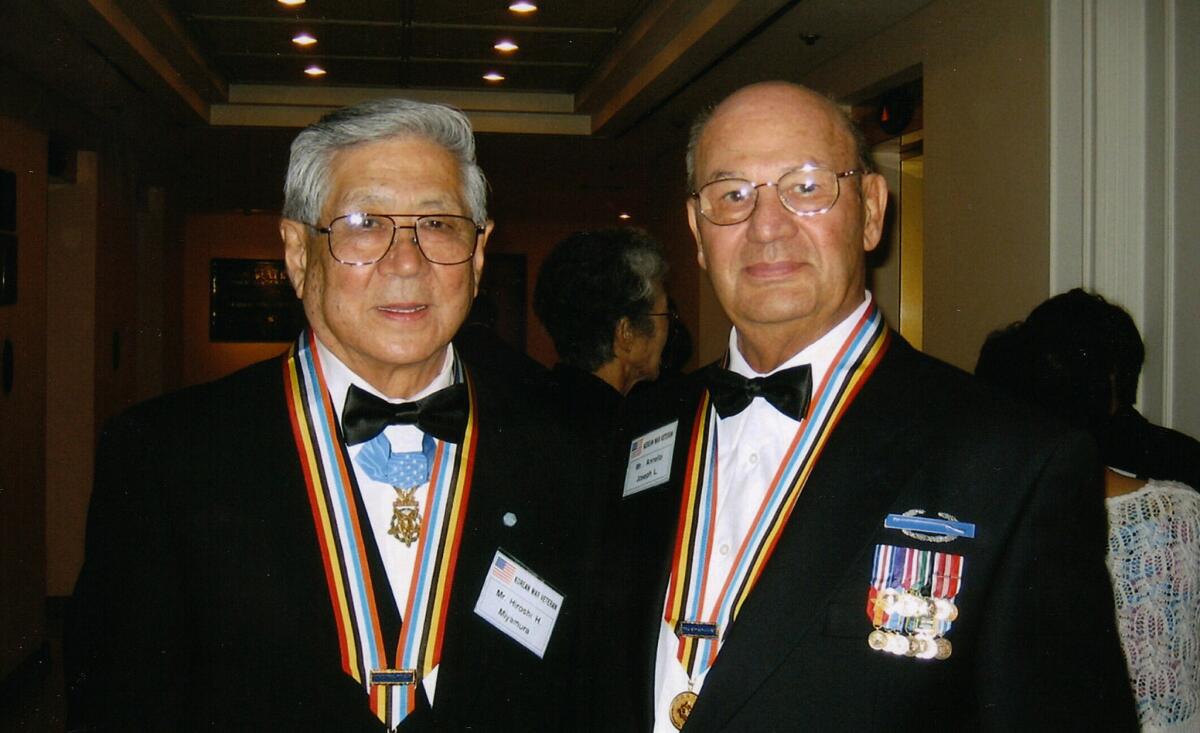
‘Oh, thank you, thank you’
Many of Miyamura’s friends and family members moved away as Gallup struggled economically, but the Miyamuras vowed to stay. They raised their three children there.
For three decades, Miyamura ran a filling station and repair shop, Humble Oil, on the western edge of town.
Diagnosed with post-traumatic stress disorder, he struggled with depression and anger and tried to forget the war. With treatment, he began to attend veterans and Medal of Honor events, often with Annello.
“From the first day we met in that tent,” Annello said, “we knew we were going to become friends.”
The city honored Miyamura with a statue and named a new high school and freeway interchange after him.
At 91, he lives in the same modest ranch house he bought in 1954, with a rock garden in front. Terry, his wife, died two years ago.
When he goes to Blake’s to eat a hamburger, other customers bring their children to meet this American hero and thank him. After so many decades, he still looks surprised and embarrassed by the attention.
“Oh, thank you, thank you,” he says.
He is saddened by the rancor he sees today in America. Sometimes he wishes people were more tolerant of each other, as they once were in a sand-grit cowboy town long ago.
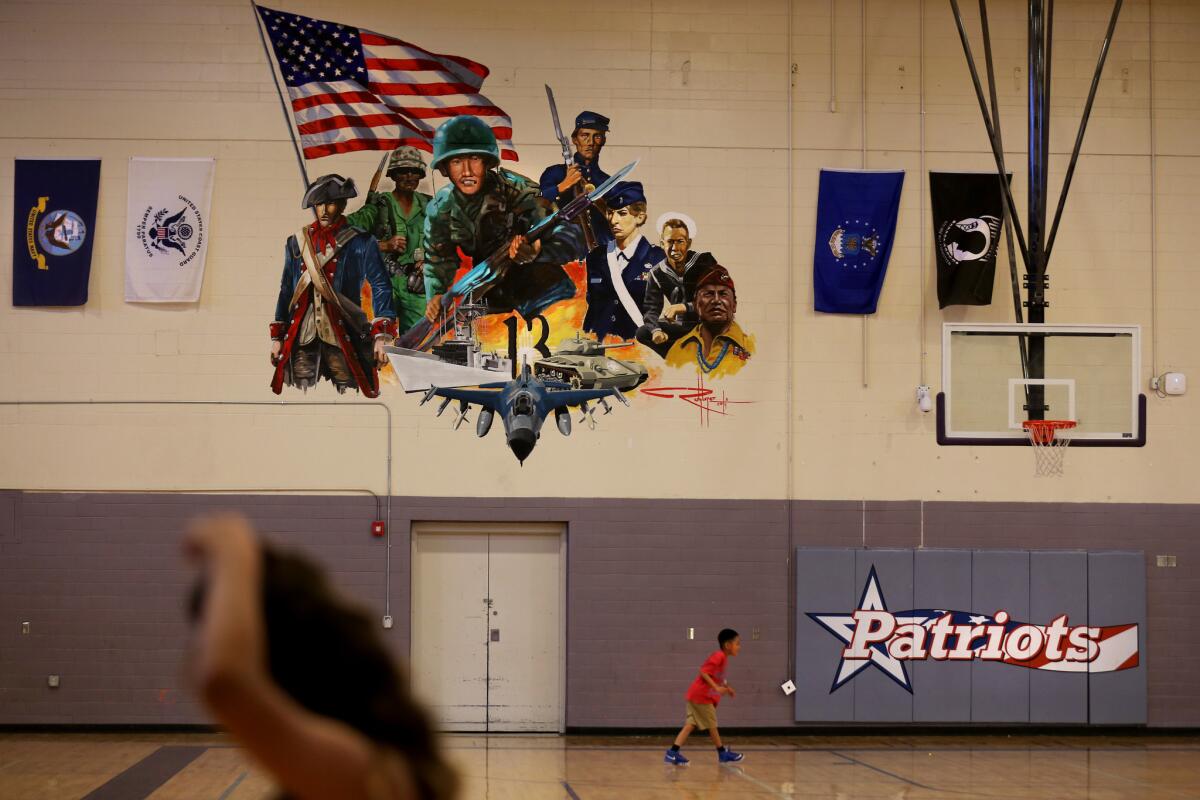
ALSO
Our national parks can also be reminders of America’s history of race and civil rights
Sign up for Essential California
The most important California stories and recommendations in your inbox every morning.
You may occasionally receive promotional content from the Los Angeles Times.








